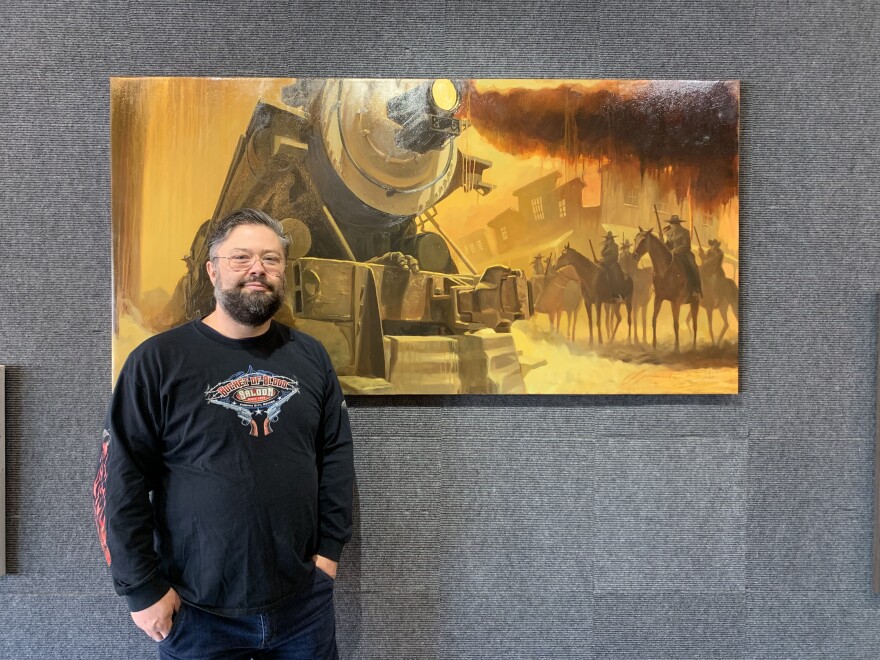The American West has inspired countless artists. But that holds especially true for one prominent artist from the region. Gabe Leonard is a Gillette native who calls himself the "Cinematic Artist."
His canvases feature whimsical, noir scenes of cowboys, saloon girls, and gangsters. And his collectors have a style to match, including Quentin Tarantino and Charlie Sheen. Leonard frequently returns to Wyoming re-immerse himself in its landscape and culture. During his most recent visit, Wyoming Public Radio's Catherine Wheeler sat down with him to talk about his artwork and its beginnings.
Catherine Wheeler: How did you first start out?
Gabe Leonard: I was working at Macy's folding shirts for minimum wage, which was the only job I could find, and struggling to get by. And I went with my roommate of mine down to the boardwalk at Venice Beach one day and saw some artists selling their artwork down there. And it kind of dawned on me that if they could be doing this, so could I. So I got my portfolio went down to the boardwalk, laid down a blanket on the ground, and set up my stuff and made $9 with some color copies from Kinkos that I made. [It] cost me $6 to park, but it was still profitable at a $3 profit. It was kind of a proof of concept that maybe I can make a few bucks. And I needed all the few bucks I could get.
CW: Was there any moment when you were selling your art on the pier and on the ground that you just thought you couldn't do it anymore like you really wanted to give up?
GL: I had nothing to give up to. There was no backup plan. This was the only thing that worked for me. Like, there was no job that paid better. So if I couldn't make money selling it that way, I'd have to figure out how to do it somewhere else. So there was never a thought that I would be able to quit. It's like how do I quit having brown hair?
CW: What is it about the cowboy or Western America, what about that is connecting with you and why is it coming through in your art?
GL: Well, a lot of that comes from growing up in Wyoming. And when I started doing the outlaw stuff, I was in my early 30s. At the time I was also interested in history, and I was reading up and studying a lot of the American history and especially in the west, around where I grew up. And growing up here, I didn't appreciate it at the time and I wasn't really wasn't interested in what happened here. And I started imagining what it would be like to be in Wyoming in the late 1800s with no electricity, no running water. So I thought what if I created these characters that had that rough sort of attitude about themselves. So I drew upon just my own experience of people I grew up with and the environment I grew up in. And I sort of put that in those paintings. And I wanted them to be entertaining. I wasn't angling for it to be Western art. I wanted it to have sort of as a theme of what was going on, but I wanted the main thrust of it to be the personalities and attitudes of the people that were there.
CW: So how has your work changed from then to now?
GL: The work was really more focused on referencing from specific historical characters and people and I think my work now -especially in the outlaw/Wild Wild West genre- is more metaphorical. If you have an American mythology that's would be more what it is. I think the Western cowboy character is something uniquely American. So I use those things as a storytelling device or maybe a philosophical point of view, without overburdening somebody with a bunch of, like, high and mighty points of view. So there's a lot of ambiguity in what I put into the work as far of the storylines so people can read what they want to read into it.
CW: You're from Gillette. Why is it important for you to come back here every so often?
GL: It helps me to reconnect with those memories and ideas. The farther you get away from your past the more you romanticize it, and the more you forget things. So just coming back-especially coming back in the winter-it reminds me of what it was like to be here. Things you forget, like, the just way the snow looks, the different types of snow, the smells, all those sort of things. And that goes into any part of creating the artwork, the more connection I can have to it the better, the deeper the work becomes.
CW: How do you see your work evolving in the future?
GL: I'm always looking for better ways to do things, more efficient ways. I do lots of things besides all the outlaw and Wild West stuff. I'm working on an idea that involves people doing tough jobs. I'm tentatively calling it "Grit," which invokes some of the oil field workers up here recently and the coal truckers and mines. And I'm looking to do maybe some firefighters and forest services characters and stuff. I'm always looking into broadening the horizons of what I do. One thing I don't really want to do is to be pigeonholed into just doing Western stuff because if you do something like anything for too long you get burnt out on it and get tired of your own work. The main goal is to keep things fresh and interesting for me and find things to do that allow me to learn more about the things around me and or more about myself.







